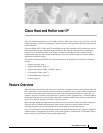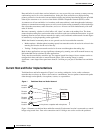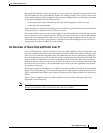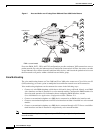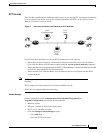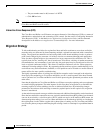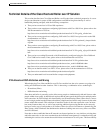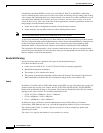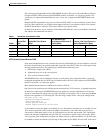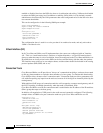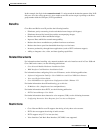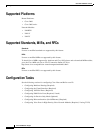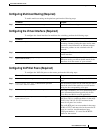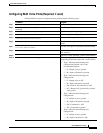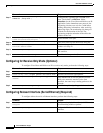
Cisco Hoot and Holler over IP
Feature Overview
9
Cisco IOS Release 12.1(5)T
The uncompressed bandwidth includes IP/UDP/RTP headers (40 bytes) in the bandwidth calculation.
Compressed RTP (cRTP) reduces the IP/UDP/RTP headers to between 2 to 4 bytes per packet. The
calculation of compressed bandwidth below uses 4 bytes for a compressed IP/UDP/RTP header per
packet.
Maximum RTCP bandwidth is five percent of the total RTP traffic in a hoot and holler session. Since
the Cisco Hoot and Holler over IP application supports mixing of a maximum of three voice streams,
the RTCP bandwidth is limited to five percent of three-voice-stream traffic.
In addition to the above, Layer 2 headers (Frame Relay, PPP, Ethernet, and so on) should be considered
and added to the bandwidth calculation.
Table 1 Bandwidth Consideration Table
cRTP, Variable-Payload Sizes and VAD
Some network administrators may consider this amount of bandwidth per call unacceptable or outside
the limits for which they can provide bandwidth, especially in the WAN. There are several options that
network administrators have for modifying the bandwidth consumed per call:
1. RTP header compression (cRTP)
2. Adjustable byte-size of the voice payload
3. Voice activity detection (VAD)
IP/UDP/RTP headers add an additional 40 bytes to each packet, but each packet header is basically
unchanged throughout the call. cRTP can be enabled for the VoIP calls, which reduces the IP/UDP/RTP
headers to between 2 to 4 bytes per packet.
More detailed documentation on cRTP can be found on CCO at:
http://www.cisco.com/univercd/cc/td/doc/product/software/ios121/121cgcr/qos_c/qcprt6/qcdcrtp.htm
In addition to reducing the IP/UDP/RTP headers per packet, the network administrator also has the
option of controlling how much voice payload is included in each packet. This is done using the bytes
keyword and argument in a VoIP dial-peer. The following example shows a dial-peer configuration:
dial-peer voice 1 voip
destination-pattern 4085551234
codec g729r8 bytes 40
session protocol multicast
session target ipv4:239.10.108.252:20102
As the number of bytes per packet is modified, so too is the number of packets per second that are sent.
Voice activity detection (VAD) enables the DSPs to dynamically sense when there are pauses in a
conversation. When these pauses occur, no VoIP packets are sent into the network. This significantly
reduces the amount of bandwidth used per VoIP call, sometimes as much as 40 to 50 percent. When
voice is present, then VoIP packets are again sent. When using Cisco Hoot and Holler over IP, VAD must
be enabled to reduce the amount of processing of idle packets by the DSPs. In basic VoIP, VAD can be
Codec
Payload Size
(byte)
Bandwidth/ Voice Stream
(Kbps)
RTCP Bandwidth per
Cisco Hoot and Holler over IP
Session (Kbps)
Example—One Voice Stream in a
Session (Bandwidth in Kbps)
Uncompressed Compressed =(1)*n+(3) =(2)*n+(3)
g.729
20 24 9.6 3.6 27.6 13.2
g.726
80 48 33.6 7.2 55.2 40.8
g.711
160 80 65.6 12.0 92.0 77.6



